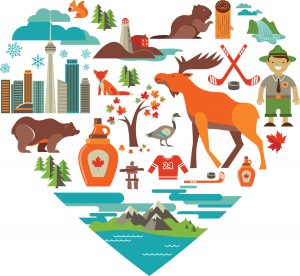Online Content
150 Little Know Canadian Facts #10
April, 2017

57. Our prairie provinces have always been known for their top-quality wheat; however, farmers haven’t had it easy growing it because of the prairie’s long winters and short summers being at odds with wheat’s long maturing time. One particular variety called Red Fife (which was the staple Canadian wheat crop), has a particularly long maturing time, yet has great yields and baking qualities. Around 1889, Dr. W. Saunders realized there was a need to develop an early maturing wheat. In 1892, his son Percy was able to cross Red Fife with a variety from India called Hard Red Calcutta, which was an early maturing variety but lacked high yields and quality. Saunders’ other son, Charles, then took that early hybrid of wheat, which he named Marquis, and sent it to experimental farms across the prairies. Its growth, maturity and quality were so good that by 1920, 6.9 million hectares of seeded prairie farmland was 90% Marquis wheat. Most of the wheat currently grown in Canada comes from that hybrid.
58. Canadian prairie farmers learned a difficult lesson in The Dirty Thirties. Along with a devastating El Niño that caused drought, the soil was overworked, the summers were brutally hot and powerful winds created massive dust storms. The conditions were perfect for an explosion of grasshoppers and gophers. Some families actually ate the gophers to survive, while the government offered a penny per gopher tail that amounted to over $1 million paid out to Alberta and Saskatchewan alone. With the 1929 Stock Market Crash, wheat was worthless. In 1928, one bushel of No. 1 Northern wheat brought in $1.03, and by 1932, it was $0.29. However, out of all this, the government put in place the Prairie Farm Rehabilitation Organization (PFRO) to teach soil and water conservation and management techniques to farmers. The PFRO also provided insurance for crop failures.
59. Canada has some magnificent waterfalls. Though Niagara Falls is famous, it’s not the highest. In fact it doesn’t even crack in the top five. The highest waterfall (with a vertical or near vertical drop) is Della Falls, BC, with a drop of 440 m (1443 ft) and it’s also the 16th highest in the world. Next in line are Takakkaw Falls, BC, at 254 m (833 ft); Hunlen Falls, BC, at 253 m (830 ft); Panther Falls, AB, at 183 m (600 ft); and in fifth place is Helmcken Falls, BC, at 137 m (449 ft).
60. Kenojuak Ashevak (1927-2013) was one of the most highly acclaimed Inuit Dorset artists in Canada. Her art has been represented in nearly every annual print collection since 1959. Her most famous piece “The Enchanted Owl” was on a 1970 stamp that commemorated the Centennial of the Northwest Territories. Along with other artists, she was commissioned by Via Rail Canada to make a large mural for its Club Car Series. In April 1999, Dorset Fine Arts put 99 of Kenojuak’s prints put into a special edition diptych to celebrate the new Canadian territory Nunavut. The piece was entitled “Siilavut, Nunavut,” which means “Our Environment, Our Land.” Kenojuak is also the first Inuit artists to be inducted into Canada’s Walk of Fame.
61. During the Cold War, it was common for governments to construct nuclear fallout shelters that they could retreat into in case of a nuclear crisis. Canada was no different. Under the leadership of Prime Minister John Diefenbaker, the government constructed the “Central Emergency Government Headquarters,” an underground bunker located in a field just west of Ottawa. This bunker could house 565 government officials for a period of one month, which they hoped would be long enough for the radiation to subside. Today the shelter is open to the public as a museum and is affectionately called “The Diefenbunker.”
62. When China opened itself to diplomatic relations with the West in the 1970s, Western leaders found themselves in competition to impress China with lavish gifts so that they, in turn, stood a chance of obtaining gifts from China. Specifically, they wanted to receive panda bears for their zoos.
After President Nixon’s success in obtaining pandas, Prime Minister Pierre Trudeau travelled to China with four beavers in tow, thinking that they could exchange national symbols. But when he arrived in China, officials were confused as to why he had brought four “water rats” with him on a diplomatic trip. While the confusion was eventually corrected and diplomatic relations were strengthened between the two countries, Trudeau never did receive his pandas.
63. Canada’s Parliament Buildings were first constructed between 1859 and 1866 in anticipation of the upcoming confederation agreements, though those aren’t the same buildings that you can see today. In 1916, a fire consumed parliament, leaving only the federal library in tact. The new Parliament Building, this time constructed out of concrete and steel, wasn’t completed until 1928.
64. During the Second World War, Japan was experimenting with many new kinds of secret weaponry. One of these new weapons was, in essence, a bomb tied to a weather balloon. The Japanese army would make hundreds of these balloons and send them gently over the Pacific, where it was hoped they would cause massive damage. Over 60 of these balloons touched down in Canada during the war, but luckily for us, none of them resulted in casualties. While most landed in the coastal regions of British Columbia, some were reported to be found as far east as Manitoba.
- Canada 150
- Canada's fallout shelters
- china
- Dirty Thirties in Canada
- Dorset Fine Artists
- Parliament Buildings in Canada
- Pierre Trudeau
- waterfalls
- wheat
- WWII











